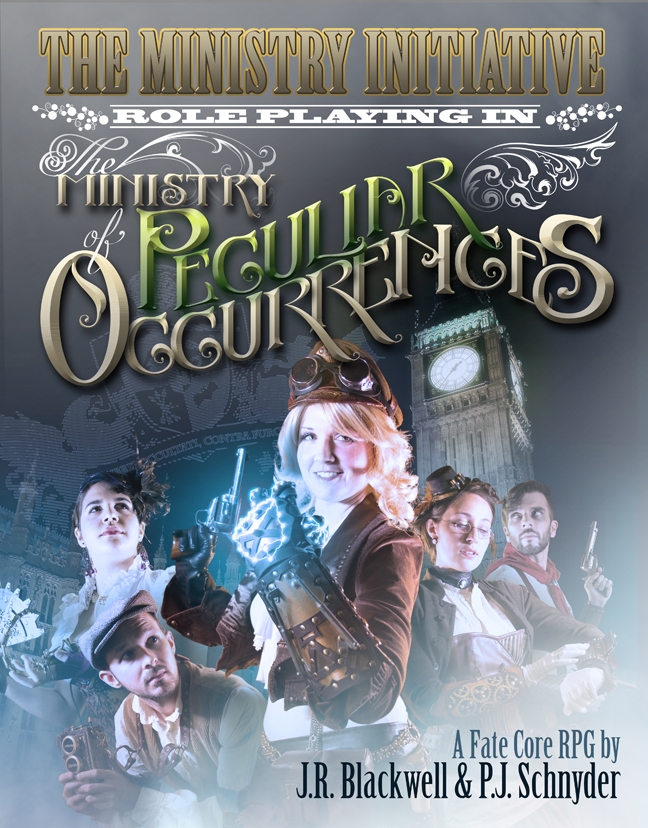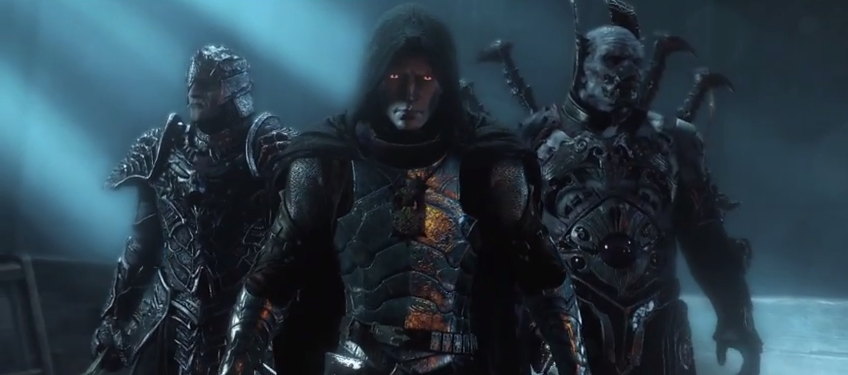This week I reviewed The Ministry Initiative: The Ministry of Peculiar Occurrences. Before I dig into the meat of the review I have a couple of things I’d like to note. First, I’m a systems person. If you read the Age of Electrotech review, you already know what I’m going to say next; I’m going to spend most of this review talking about the system presented in The Ministry of Peculiar Occurrences (TMPO). Second, I’ve got a bit of a crush on steampunk and that likely put a few bonus points in the appropriate column for this particular RPG. Consider yourself warned of my potential bias.
Onward to the reviewing!
I’ll get the art and design elements out of the way for you visual people. The cover art is in keeping with the theme, but it’s about the only thing I didn’t enjoy about TMPO. Before those of you who adore it raise up torches and steampunk pitchforking machines to strike me down, allow me to explain: it’s busy and it has real people in it. There’s something about a drawing that lets my imagination tailor things in a way that I intimately associate with RPGs and creating unique characters. Seeing real people on the cover jars me out of that mode. Nitpicky? Yes, it is, so I recommend you take a gander at the artwork and make your own decision if you don’t trust mine. Don’t worry, I won’t take it personally.
If that initial bit of bad had you moping, fear not! The rest of this RPG is completely awe-inspiring, as far as I’m concerned. It does a wonderful job of setting up the victorian steampunk vibe. Understated notices that have a deliciously British feel to them are scattered throughout the book. While the intention is largely to inform, they do so in a way that does as much to set the scene as the descriptive and story elements included within.
Now, I’ve tinkered around with designing my own gaming systems before and the one in use here makes me jealous. It is that good. Instead of focusing on XP and lots of numerical stats, the Fate Roleplaying System makes innovative use of +, -, and blank dice mechanics in combination with ‘fate points’ that can be used to nudge the outcome of the story, and categorical, story-driven character elements in the form of aspects and consequences that define and develop your character. In fact, I’ve only ever seen one dice system similar to this and that was in the d2 RPG The Coin’s Hard Edge. I’ve yet to encounter another RPG that focuses on and translates the events of a game into character development the way the Fate RPS does. This sort of system not only tolerates people new to tabletop RPGs, it manages to maintain the sort of depth that most old school RPG players like myself desire. The lack of omnipresent numerical stats and categories does not make for a lack of depth, as I discovered.
The fate points warrant a bit of further description. They are points that can alter the outcome of an action, but they do have an interesting wrinkle that separates them from the typical ‘willpower’ spends in certain other RPGs. Players have aspects that describe certain elements of their character. These aspects can be invoked or compelled. Invoking simply uses stored fate points to alter an event or outcome. Compelling, however, is a ready handle for the GM to create interesting, organic stories as well as a way for the players to exercise a bit of strategy. Suppose your character has a weakness for something, let’s say gambling. The GM can offer a compel, tempting your character to indulge in a bit of a gambling binge while they’re on a mission. If you accept, you gain a fate point. If you decline, you need to spend a fate point. As you can imagine, this opens up a sort of ‘meta-strategy’ to the game that not only encourages players to have real, interesting characters that sometimes make mistakes, it can allow you to hoard fate points for use later in the story where the outcomes really matter.
There is so much to The Ministry of Peculiar Occurrences that I can’t spare the words to describe it all, lest this piece become an unreadable monster. It should suffice to say that the entirety of its design is geared towards creating organic stories, human characters to populate them, and outcomes that may not be entirely expected. It keeps it fresh, it makes it easy, and it avoids tedium through clever machinations as well as an entertaining setting that allows for a wide range of possible characters, devices, and situations.
If you love steampunk or things British in nature, this is a must buy. It’s also great if you’re looking to take your first steps into tabletop RPGs as it is easy to learn and replete with handy, well-written guides for both players and GMs. There aren’t a lot of rule structures and what rules there are feel natural, like the use of the aforementioned aspect system to define unique, complex characters. One particular point of pride for TMPO is that the GM portion is so in depth, so beautifully designed, that it could be used to teach a first year college writing workshop. I’m being totally serial here, guys, and I’ve got a BA in creative writing.
To sum it all up, on my ranking scale of Would Play It to Wouldn’t Play It, I give it an enthusiastic, steam-powered Would Play It. This is the kind of game that makes believers out of first timers.


